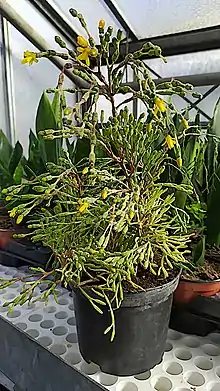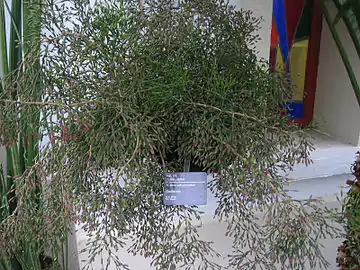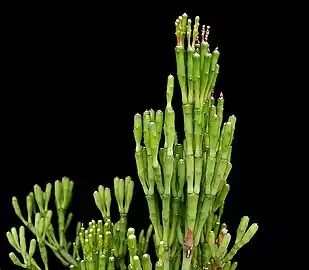Hatiora salicornioides
Hatiora salicornioides, the bottle cactus, dancing-bones, drunkard's-dream,[3] or spice cactus,[4] is a species of flowering plant in the cactus family. A member of the tribe Rhipsalideae, it often grows as an epiphyte, natively in eastern Brazil and ornamentally elsewhere.
| Hatiora salicornioides | |
|---|---|
 | |
| Scientific classification | |
| Kingdom: | Plantae |
| Clade: | Tracheophytes |
| Clade: | Angiosperms |
| Clade: | Eudicots |
| Order: | Caryophyllales |
| Family: | Cactaceae |
| Subfamily: | Cactoideae |
| Genus: | Hatiora |
| Species: | H. salicornioides |
| Binomial name | |
| Hatiora salicornioides (Haw.) Britton & Rose | |
| Synonyms[2] | |
| |

Description
Hatiora salicornioides grows to about 1 m (3 ft) tall with an erect to pendent growth habit. Its stems are composed of segments 1.5–5 cm (0.6–2.0 in) long. Each segment is shaped like a club or bottle, with the narrower end at the base. The stems branch from the end of a segment, with up to six branches forming a whorl. The yellow to orange flowers are borne at the ends of younger stem segments, and are 1–2 cm (0.4–0.8 in) long and about the same across when open. Translucent white berries follow the flowers.[5]
 Growth habit in cultivation
Growth habit in cultivation Branching
Branching
Taxonomy
The species was first described by Adrian H. Haworth in 1819, as Rhipsalis salicornioides. Haworth had actually spelt the epithet "salicornoides"; subsequent authors have corrected the spelling, treating the original as an orthographic error.[6] The International Plant Names Index later deemed the specific epithet incorrectable to "salicornioides" as is it derived from a noun and a suffix rather than two Greek or Latin words.[7] The epithet means "similar to Salicornia". The species was placed under the genus Hatiora in 1915, after previously belonging to the “lost” (and ultimately, abandoned) genus of Hariota.[2] Molecular phylogenetic studies have confirmed its placement in the correct genus, and also in the tribe Rhipsalideae, showing a close relation to H. cylindrica (which has been considered synonymous with H. salicornioides, as a cultivar/form or variety). H. salicornioides is highly variable, as many succulent plants can be, and may possibly include other distinct species.[8][9]
Distribution and habitat
Hatiora salicornioides is found slightly inland of the oceanic coastal regions of Brazil, in states that are the nearest to the Atlantic Ocean, although it is not typically found directly at sea level. This home range encompasses most of the eastern, northeastern, southeastern, and southern areas of Brazil’s lengthy coastline. States and regions where these plants are known to be found include Bahia, Espírito Santo, Minas Gerais, Rio de Janeiro state, São Paulo state and Paraná, in the south. This vast (and fragile) stretch of land contains dense and relatively still-in-tact forest habitats, burgeoning with endemic flora and fauna. The high rate of growth and large number of unique plants is attributed to the generally constant year-round temperatures, combined with high ambient humidity (of the rivers, fog, and dew, in addition to regular rain showers/storms). In these jungles, the limbs of trees are some of the best places to find these epiphytic cacti, where they typically are utilising the tree structures as a permanent, communal home with other plant species. Each internode (part of the plant where each leaf connects with the next) of the cactus will send out sticky, aerial roots to anchor and adhere the plant to the growing surface. Once stability is achieved, the plants gradually grow and transform, moving slowly up to the sunlight.
Every available space is used to its maximum potential in these productive rainforests, with the plant-laden trees giving an almost “dripping” appearance. Their branches and trunks serve as a home for epiphytic species, often being completely covered with various tropical cacti, ferns, orchids, bromeliads, aroids, mosses, Peperomia, and more.[1][2] In addition to thriving in moist forest, these diminutive cacti are also found growing on trees in the more open savanna habitats, rocky outcrops, humid canyons, as well as montane regions, at elevations of 200–1,750 m (660–5,740 ft). It is seldom, if ever, found rooted into the ground, and nearly always found growing epiphytically or as a lithophyte.[1] Over many years, a mature plants’ roots will end up growing in many directions; this includes horizontally, vertically, as well as down, touching the ground and soil. A large plant, with roots extending down from the treetops, will gain additional nutrition from the soil, while remaining firmly anchored in place.
Cultivation
Hatiora salicornioides is grown as an ornamental plant. It requires some humidity, and is not frost-tolerant. Light shade and a minimum average temperature of 12 °C (54 °F) are recommended. Given these conditions, it has been successfully cultivated outside in Phoenix, Arizona. In climates with lower winter temperatures, it is cultivated in greenhouses or as a house plant. It is propagated by stem cuttings.[4][10]
In the UK Hatiora salicornioides has gained the Royal Horticultural Society's Award of Garden Merit.[11]
See also
References
- Taylor, N.P. & Zappi, D. (2017), "Hatiora salicornioides (amended version of 2013 assessment)", The IUCN Red List of Threatened Species 2017, International Union for Conservation of Nature, doi:10.2305/IUCN.UK.2017-3.RLTS.T152161A121524550.en
- "Hatiora salicornioides (Haw.) Britton & Rose", Plants of the World Online, Royal Botanic Gardens, Kew, retrieved 2019-07-12
- "Hatiora salicornioides". Germplasm Resources Information Network. Agricultural Research Service, United States Department of Agriculture.
- Faucon, Philippe, "Drunkard's Dream, Spice Cactus", Desert Tropicals, retrieved 2019-07-12
- Anderson, Edward F. (2001), The Cactus Family, Pentland, Oregon: Timber Press, ISBN 978-0-88192-498-5, p. 377
- Barthlott, W. & Taylor, N.P. (1995), "Notes towards a monograph of Rhipsalideae (Cactaceae)", Bradleya, 13 (13): 43–79, doi:10.25223/brad.n13.1995.a7, S2CID 89883634
- "Rhipsalis salicornoides | International Plant Names Index". www.ipni.org. Retrieved 2023-02-24.
- Calvente, Alice; Zappi, Daniela C.; Forest, Félix & Lohmann, Lúcia G. (2011), "Molecular phylogeny of tribe Rhipsalideae (Cactaceae) and taxonomic implications for Schlumbergera and Hatiora", Molecular Phylogenetics and Evolution, 58 (3): 456–468, doi:10.1016/j.ympev.2011.01.001, PMID 21236350
- Korotkova, Nadja; Borsch, Thomas; Quandt, Dietmar; Taylor, Nigel P.; Müller, Kai F. & Barthlott, Wilhelm (2011), "What does it take to resolve relationships and to identify species with molecular markers? An example from the epiphytic Rhipsalideae (Cactaceae)", American Journal of Botany, 98 (9): 1549–1572, doi:10.3732/ajb.1000502, PMID 21900612
- Anderson, Miles (1999), Illustrated Encyclopedia Cacti and Succulents, Oxford: Sebastian Kelly, ISBN 978-1-84081-253-4, p. 82
- "Hatiorna salicornioides". www.rhs.org. Royal Horticultural Society. Retrieved 19 July 2020.
